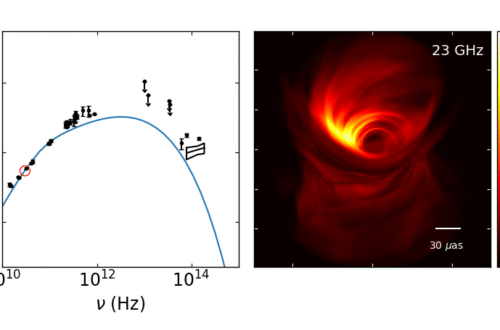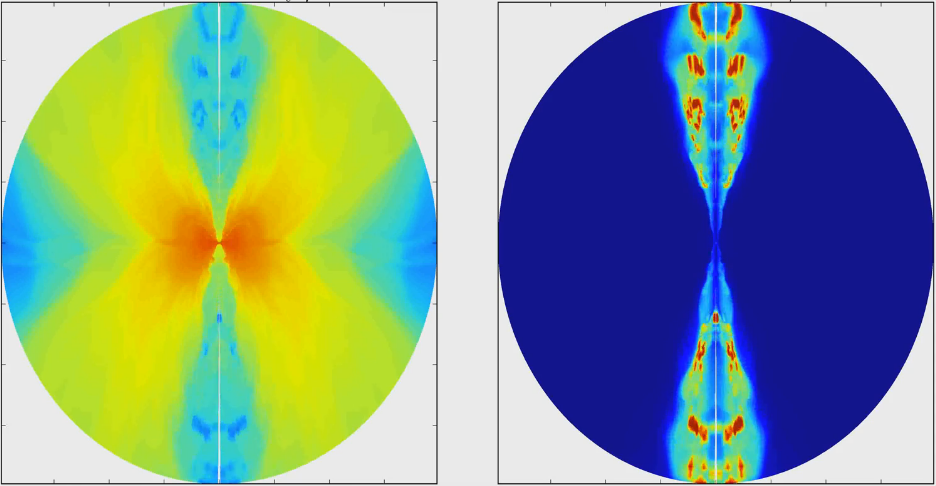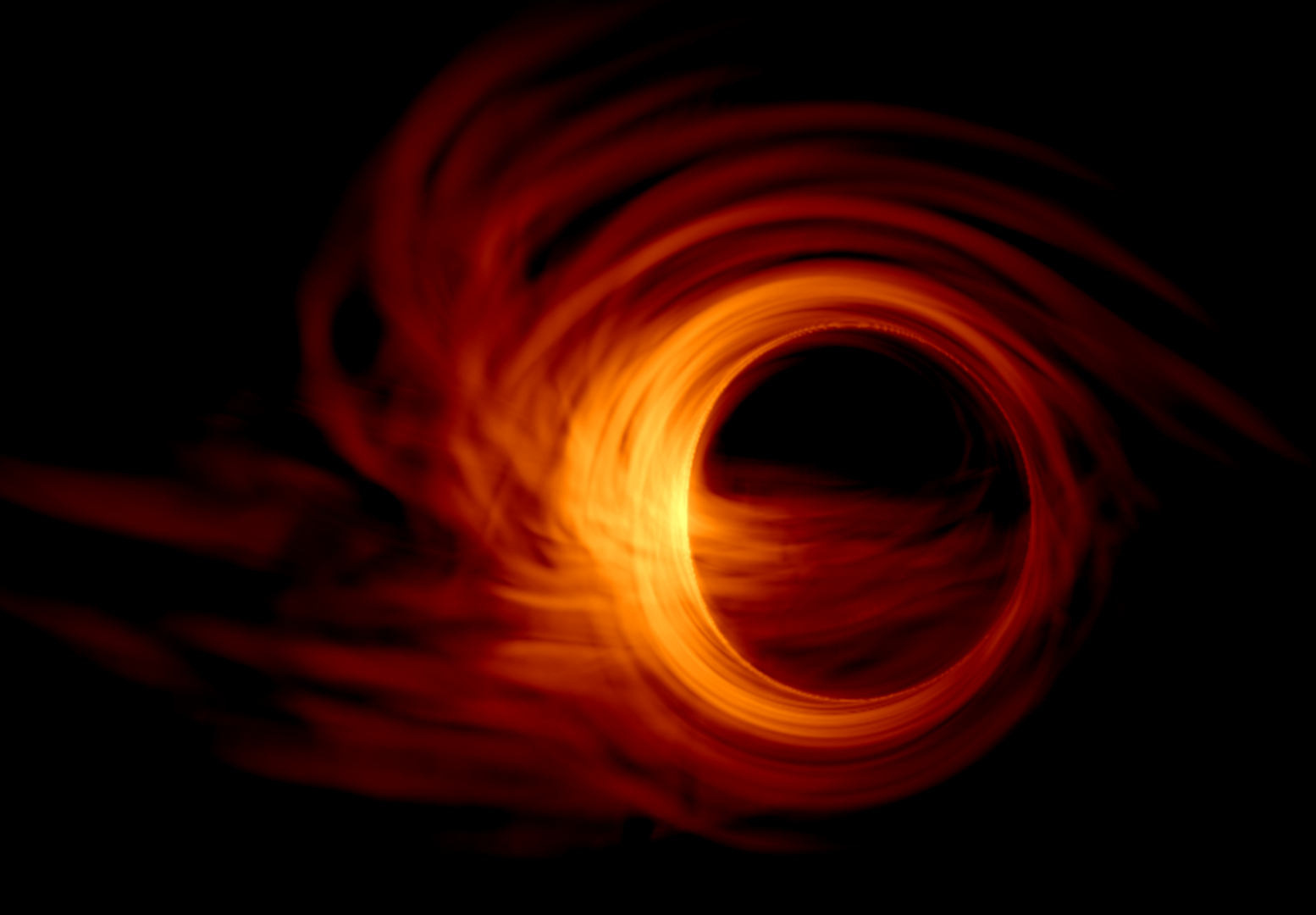My name is Tobias Beuchert. I recently joined this group as a postdoc. My research interests are to expand our knowledge about accreting compact objects (black holes or neutron stars), their energy consumption and energy release.
Disclaimer: this blogpost may contain one or two elements of slightly exaggerated content. This is an attempt to make the astonishing nature beyond our habitable horizon a little bit more accessible.
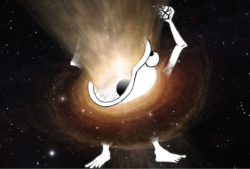
Imagine a vacuum cleaner that does not simply suck in matter, but feeds from an orbiting disk of dirt in your living room just like water forming a funnel before disappearing in the sink. Now, remove the bag inside the vacuum cleaner and open the lid: voilà. Parts of the stuff will still “disappear” inside the device. Large parts, however, will be shot against the ceiling. The driving force is the built-in engine. Accreting black holes work in a similar but less well-understood way. Here, the black hole functions as the “engine” (a term used by D. Meier in his book “Black Hole Astrophysics – The Engine Paradigm”) or “monster” (a term that I like to use not too seriously in public talks) in the most extreme cases. It extracts energy from the gravitational potential of accreting material and returns a lot of energy back into the environment. Besides matter being thrown out perpendicular to the probably rather flat accretion disk, such vivid compact objects are also strong emitters of radiation from the radio to gamma rays. We therefore combine observational efforts across the entire electromagnetic spectrum with state-of-the-art spectral models to learn more about these systems.
During my PhD, I have studied several of the above described phenomena for the largest black holes known, which reside in distant galaxies. I focused on Active Galaxies, which, unless our Milky Way, actively consume and release heaps of energy. As researchers, we should always be aware of the immense challenges that we are mastering every day. The mechanisms that I just described operate on spatial scales that lie below the resolution limit even of modern telescopes – they correspond to making a photo of a screwdriver on the moon. Unveiling the hidden is one of our major tasks. Let me guide you through some exciting aspects on how we can still learn about what is going on there.
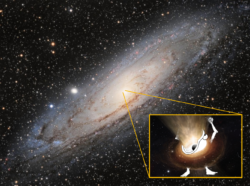
X-ray spectroscopy
First, we know that in order to allow matter to spiral towards the black hole inside Active Galaxies, the disk releases energy via X-ray radiation. This radiation passes through all the gas and dust that orbits the black hole further out. We can therefore “X-ray” this matter just like it is done in the hospital. Note that the German term is “to röntgen”, named after the German Physicist Wilhelm Conrad Röntgen, who was the very first to invent X-ray imaging, X-ray his wife’s hand, and just after his beloved deer rifle.
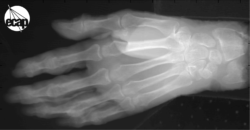
In a nutshell, X-ray spectroscopy allows us to measure the amount of gas per line of sight that is absorbing our view onto the X-ray source. For comparison, the absorbing atoms on our line of sight through both our own galaxy and the much denser material around the central black hole of the distant galaxy corresponds approximately to the number of atoms per line of sight through our hand!
We find via multiple measurements that absorption variability can be caused by dynamic gas and dust close to and influenced by the gravity of the black hole. This is similar to clouds passing over the sun, as illustrated below.
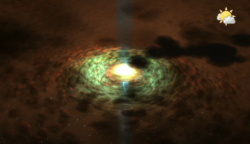
Radio Interferometry: imaging jets
Although we can not resolve out the central engine, we can well image outflows of matter in Active Galaxies (their “feedback”) that are rooted in the engine’s environment: the most powerful outflows are “jets” that remain magnetically collimated at distances that are about one million times larger than the size scale of the engine or nucleus. These jets are strong emitters of radio synchrotron emission and can be mapped out with networks of radio telescopes. Me and my collaborators focused on the jet emerging from the galaxy 3C 111 as illustrated below. The resolving power of the Very Long Baseline Array on the Northern Hemisphere allowed us to infer important insights in jet physics. Most importantly, we could map out the long-term evolution of the electric field vectors of the polarized jet emission. We also found evidence for a re-collimation of the flow at ~10^5 gravitational radii.
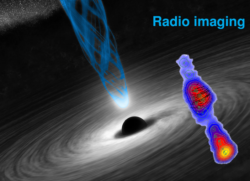
Accretion and Feedback at their extremes
Many analogs can be drawn from super-massive black holes inside distant galaxies to stellar-mass compact objects. Both are suspected to accrete material and emit across the electromagnetic spectrum. The most extreme of these small-scaled compact objects, however, also leave the most open questions. “Ultraluminous X-ray sources” are unprecedented in their brightness. It is thought that they source their energy from matter being attracted at extremely high rates. This regime still lacks much of our understanding and needs to be probed with all possible means. Me and my collaborators focus on identifying peculiar feedback mechanisms that may arise in these systems as consequence of the extreme mass-attraction rates. These objects and their suspected outflows are too far away and appear too small to be imaged even at the highest resolution. How can we ever know, what is going on inside these objects? The solution that me and my collaborators pursue is to take one step back. Many of these rebels are surrounded by nebulae that are carved and ionized by the compact feedback that we try to understand. We anticipate to decrypt the information contained in such nebulae and compare these with physical models for feedback channels like large-angle winds and collimated jets. While such feedback studies have been done for a number of sources already, we will make use of physical models and their predictions for the radiation we should see. We will describe disk-winds with relativistic magnetohydrodynamic simulations (based on Jiang et al., 2014). The jets will be described with an adapted version of the jet model developed in our group.
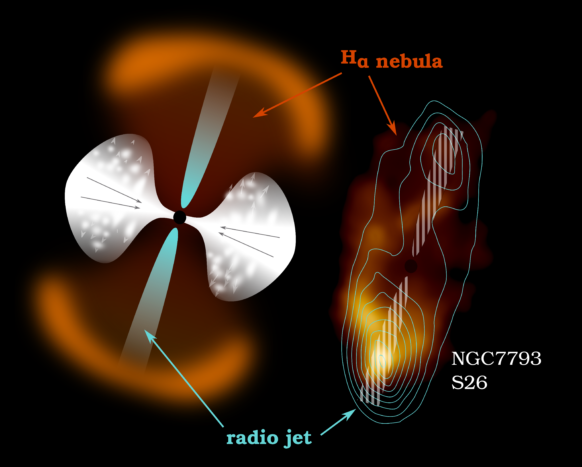
Jet morphologies
In yet another ongoing project, we combine joint efforts from theoretical simulations and observations. Several colleagues in our group push forward the development of (general) relativistic magnetohydrodynamic simulations of jets across a wide dynamic range of spatial scales. This can now be done at reasonable computational costs. These simulations confirm that the large-scale morphology of jets on galactic scales may not be due to altering jet-intrinsic physics but different properties of their hosting galaxies, where new-born jets have to pierce through. We are now able to simulate these jets self-consistently from their formation to scales, where they interact with their host galaxy. Together with Alberto Rodríguez Ardila (LNA, Brazil) and colleagues, we plan to measure the radial host-galaxy density profiles of selected cases with optical integral-field imagers. These measurements allow to setup our simulations in a way to directly compare the simulated with the observed jet morphologies.
Tobias Beuchert
I started as a PostDoc in November 2017. Besides my interest for fundamental research, I also care a lot about maintaining the critical dialog among us as researchers and among researchers and the public. We as researchers share a profound responsibility to expand knowledge in a truthful manner and to the best of our’s knowledge and belief. We do have this responsibility in front of ourselves and the community that relies on the quality of our work.
For more information, check out my homepage.
Questions? Remarks?
Feel free to contact me!

 I started as a PostDoc in November 2017. Besides my interest for fundamental research, I also care a lot about maintaining the critical dialog among us as researchers and among researchers and the public. We as researchers share a profound responsibility to expand knowledge in a truthful manner and to the best of our’s knowledge and belief. We do have this responsibility in front of ourselves and the community that relies on the quality of our work.
I started as a PostDoc in November 2017. Besides my interest for fundamental research, I also care a lot about maintaining the critical dialog among us as researchers and among researchers and the public. We as researchers share a profound responsibility to expand knowledge in a truthful manner and to the best of our’s knowledge and belief. We do have this responsibility in front of ourselves and the community that relies on the quality of our work.